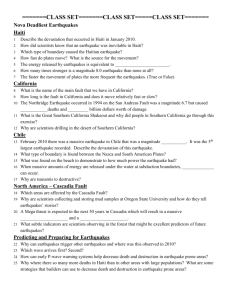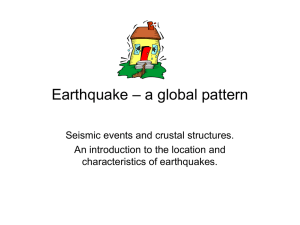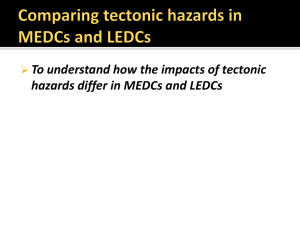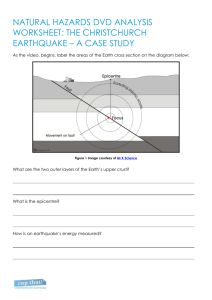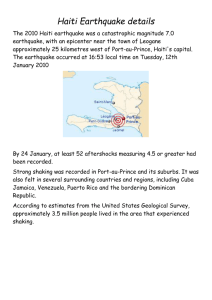A massive 7.0-magnitude earthquake has struck the Caribbean
advertisement
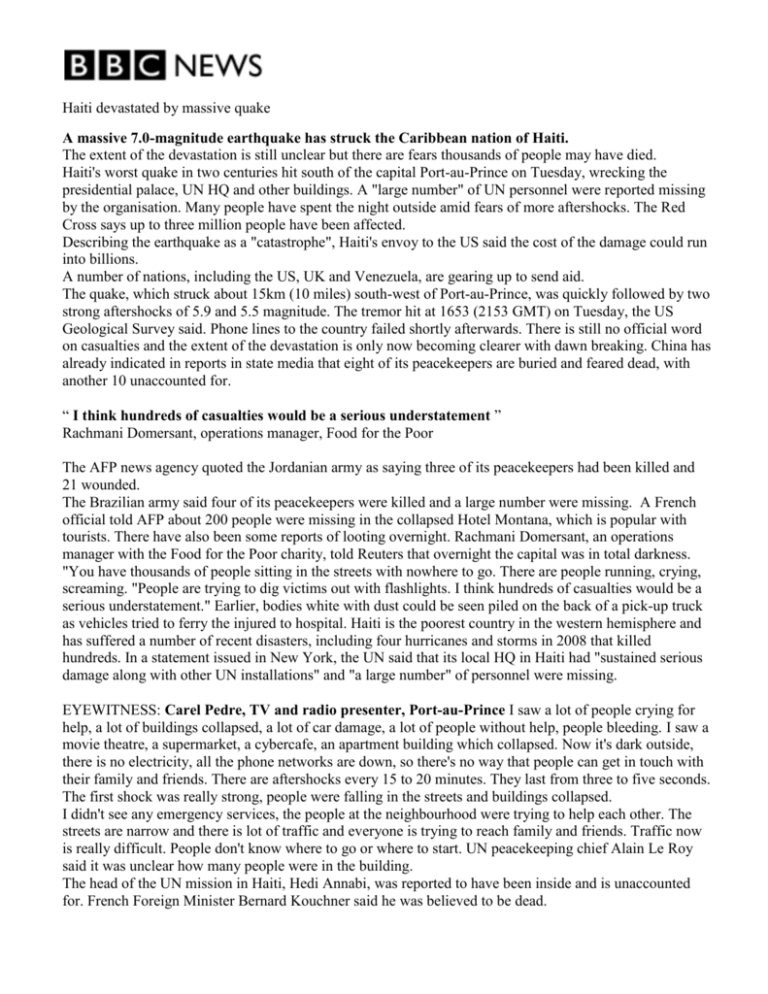
Haiti devastated by massive quake A massive 7.0-magnitude earthquake has struck the Caribbean nation of Haiti. The extent of the devastation is still unclear but there are fears thousands of people may have died. Haiti's worst quake in two centuries hit south of the capital Port-au-Prince on Tuesday, wrecking the presidential palace, UN HQ and other buildings. A "large number" of UN personnel were reported missing by the organisation. Many people have spent the night outside amid fears of more aftershocks. The Red Cross says up to three million people have been affected. Describing the earthquake as a "catastrophe", Haiti's envoy to the US said the cost of the damage could run into billions. A number of nations, including the US, UK and Venezuela, are gearing up to send aid. The quake, which struck about 15km (10 miles) south-west of Port-au-Prince, was quickly followed by two strong aftershocks of 5.9 and 5.5 magnitude. The tremor hit at 1653 (2153 GMT) on Tuesday, the US Geological Survey said. Phone lines to the country failed shortly afterwards. There is still no official word on casualties and the extent of the devastation is only now becoming clearer with dawn breaking. China has already indicated in reports in state media that eight of its peacekeepers are buried and feared dead, with another 10 unaccounted for. “ I think hundreds of casualties would be a serious understatement ” Rachmani Domersant, operations manager, Food for the Poor The AFP news agency quoted the Jordanian army as saying three of its peacekeepers had been killed and 21 wounded. The Brazilian army said four of its peacekeepers were killed and a large number were missing. A French official told AFP about 200 people were missing in the collapsed Hotel Montana, which is popular with tourists. There have also been some reports of looting overnight. Rachmani Domersant, an operations manager with the Food for the Poor charity, told Reuters that overnight the capital was in total darkness. "You have thousands of people sitting in the streets with nowhere to go. There are people running, crying, screaming. "People are trying to dig victims out with flashlights. I think hundreds of casualties would be a serious understatement." Earlier, bodies white with dust could be seen piled on the back of a pick-up truck as vehicles tried to ferry the injured to hospital. Haiti is the poorest country in the western hemisphere and has suffered a number of recent disasters, including four hurricanes and storms in 2008 that killed hundreds. In a statement issued in New York, the UN said that its local HQ in Haiti had "sustained serious damage along with other UN installations" and "a large number" of personnel were missing. EYEWITNESS: Carel Pedre, TV and radio presenter, Port-au-Prince I saw a lot of people crying for help, a lot of buildings collapsed, a lot of car damage, a lot of people without help, people bleeding. I saw a movie theatre, a supermarket, a cybercafe, an apartment building which collapsed. Now it's dark outside, there is no electricity, all the phone networks are down, so there's no way that people can get in touch with their family and friends. There are aftershocks every 15 to 20 minutes. They last from three to five seconds. The first shock was really strong, people were falling in the streets and buildings collapsed. I didn't see any emergency services, the people at the neighbourhood were trying to help each other. The streets are narrow and there is lot of traffic and everyone is trying to reach family and friends. Traffic now is really difficult. People don't know where to go or where to start. UN peacekeeping chief Alain Le Roy said it was unclear how many people were in the building. The head of the UN mission in Haiti, Hedi Annabi, was reported to have been inside and is unaccounted for. French Foreign Minister Bernard Kouchner said he was believed to be dead. The UN's stabilisation mission plays a vital role in ensuring security in Haiti. Raymond Joseph, Haiti's ambassador to the US, said the presidential palace, the tax office, the ministry of commerce and the foreign ministry had all been damaged, but the airport was intact. He and Haiti's ambassador to Mexico, Robert Manuel, both said that President Rene Preval and his wife had survived the quake. The World Bank said its local offices were destroyed but most of the staff were accounted for, Reuters reported. US President Barack Obama said his "thoughts and prayers" were with the people of Haiti and that he expected "an aggressive, coordinated [aid] effort by the US government". Venezuela says it will send a 50-strong "humanitarian assistance team". HAITI COUNTRY PROFILE Half of Caribbean island of Hispaniola History of violence, instability and dictatorship Population of 10 million people Most live on less than $2 a day Democratic rule restored in 2006 Economy in ruins and unemployment is chronic UN peacekeepers deployed - foreign aid seen as vital Massive deforestation has left just 2% forest Storms and hurricanes in 2008 left almost 800 dead The Red Cross is dispatching a relief team from Geneva and the UN's World Food Programme is flying in two planes with emergency food aid. The Inter-American Development Bank said it was immediately approving a $200,000 grant for emergency aid. The UK said it was mobilising help and was "ready to provide whatever humanitarian assistance may be required". Canada, Australia, France and a number of Latin American nations have also said they are mobilising their aid response. Pope Benedict XVI has called for a generous response to the "tragic situation" in Haiti. 'Shouting and screaming' In the minutes after the quake, Henry Bahn, a visiting official from the US Department of Agriculture, said he had seen houses which had tumbled into a ravine. "Everybody is just totally, totally freaked out and shaken," said Mr Bahn, who described the sky as "just grey with dust". He said he had been walking to his hotel room when the ground began to shake. "I just held on and bounced across the wall," he said. "I just heard a tremendous amount of noise and shouting and screaming in the distance." Reports on the Twitter message site, which cannot yet be verified by the BBC, expressed the chaos in the wake of the quake. Tweets from troylivesay spoke of the worst damage being in the Carrefour district, where "many two and three storey buildings did not make it". In the immediate aftermath of the quake, a tsunami watch was put out for Haiti, Cuba and the Bahamas, but this was later lifted. Story from BBC NEWS: http://news.bbc.co.uk/go/pr/fr/-/2/hi/americas/8455629.stm Published: 2010/01/13 12:58:19 GMT © BBC 2011 Science & Environment 22 February 2011 Last updated at 03:28 ET New Zealand earthquake: Depth and location key By Jonathan Amos Science correspondent, BBC News New Zealand sits astride a major plate boundary. Tuesday's quake was less energetic but more destructive than September's It is in the nature of earthquakes that they tend to cluster in space and time. And Tuesday's damaging tremor in Christchurch is almost certainly related to the much more energetic event that hit the region last September. But whereas last year's quake caused much less damage and no deaths, the natural disaster that struck the city on 22 February looks set to go down in the record books as one of the most catastrophic in New Zealand's history. The critical difference on this occasion is that the ground broke almost directly under the country's second city, and at shallow depth. Christchurch would have been subjected to intense shaking. Buildings weakened last year would have crumbled this time; masonry collapse was widespread, even in a city where earthquake building regulations are among the strictest in the world. “It is still possible to have big earthquakes in the tail-end of an aftershock sequence and unfortunately this appears to be one of those earthquakes” says Dr John Townend, University of Wellington. Seismologists began to record the biggest tremor, a magnitude 6.3, on their equipment at 12:51 and 43 seconds local time (23:51:43 GMT) - right in the middle of Christchurch's day. The epicentre, the point on the Earth's surface directly above where the rocks first rupture, was 10km southeast of the city. The focus, the point of rupture in the Earth itself, was a mere 5km down. Contrast this with 3 September's magnitude 7.1 event; its epicentre occurred some 40km west of the city around Darfield and at a depth of 10km, and that event continued to rupture mainly away from the major built-up areas. So although Darfield was something like sixteen times more energetic than Tuesday's tremor, the latter quake's effects would have been much more keenly felt in Christchurch this time. "There are three different places where we've recorded the acceleration of the ground being larger than that due to gravity - so the ground would actually have felt like it was moving faster than if an apple fell out of a tree," Dr Bill Fry from the Institute of Geological and Nuclear Sciences in Wellington, told the BBC. There have been a series of aftershocks following on from September's event - approximately 10 that have been greater than or equal to magnitude 5. "The September earthquake generated thousands of earthquakes that have continued since that time," explained Dr John Townend from the Victoria University of Wellington. "They had been abating slightly; the number of earthquakes per day had diminished and in the last few days we were having only one or two a day or even none. But it is still possible to have big earthquakes in the tail-end of an aftershock sequence and unfortunately this appears to be one of those earthquakes." The grander geological setting for both events is certainly the same. New Zealand lies on the notorious Ring of Fire, the line of frequent quakes and volcanic eruptions that circles virtually the entire Pacific rim. More specifically New Zealand straddles the boundary between two tectonic plates - the Pacific and Australian plates. In the north of New Zealand, to the east of North Island, the more dense Pacific Ocean plate is pulled down beneath the lighter Australian plate in a process known as subduction. To the south of South Island something similar is happening but the other way the Australian plate is being forced below the Pacific plate. On South Island itself, the location of the latest quake, a third scenario plays out. Here the plates rub past each other horizontally. This is most evident to geologists as the Alpine Fault that runs down the western spine of the land mass. It is these plate movements which drive the volcanoes and earthquakes throughout New Zealand. Dr Gary Gibson, from the University of Melbourne, Australia, commented: "On average, large earthquakes will occur less frequently in Christchurch than along the plate boundary, as has been the case for the last 200 years. "However all earthquakes in the Christchurch region will be shallow, so the effect of a given earthquake will be worse than from a deeper plate boundary earthquake of the same magnitude." A series of aftershocks continued to rattle the region on Tuesday. In the seven hours following the 6.3 tremor, there were four events that registered magnitude 5.0 or greater. "Regrettably, this earthquake is likely to trigger aftershocks of its own and while they'll probably be of smaller magnitude, they will nevertheless continue for days and weeks or even longer," said Dr Townend. "Unfortunately, this earthquake has served really to re-energise the earthquake activity surrounding the people of Christchurch; and it comes on the back of a large number of other earthquakes, so buildings have been structurally weakened and the population is that much more fraught as well." The events of recent months have stimulated a lot of thought and research. Scientists may be witnessing the consequences of blind fault activity - that is, activity on faults that does not have obvious expression at the surface because previous tremors happened so long ago the evidence for them has since eroded away. Dr Roger Musson from the British Geological Survey observed: "What we're seeing is a network of faults that people didn't know existed previously, because these are old faults. "They haven't been active for perhaps tens of thousands of years and now they're suddenly leaping in to life. It's because these faults haven't been seen before that people didn't realise that Christchurch had quite the earthquake hazard problem that it turns out to have," he told BBC News. Asia-Pacific Cable reaches Japan nuclear plant The widespread devastation caused by Japan's earthquake and resulting tsunami has been a reminder that even a country well-prepared for such disasters cannot always avoid the brutal blows of nature. With more than half a million people living in temporary shelters and panic-buying leaving stores empty of supplies, people are being reminded of the importance of government advice, which tells them to have a survival "grab bag" permanently at the ready. So what sort of things should be in such an emergency kit? The Japanese government recommends a long list of items to its citizens, but it is down to the individual to take on board the advice and prioritise what is crucial to them. Sarah Ono, who lives with her Japanese husband - a disaster specialist - and their two children in Kochi prefecture on the southern Japanese island of Shikoku, has opened up her family's three grab bags to show what she has at the ready for such emergencies. Thousands of Japanese people have lost their homes and belongings. "We have evacuation bags in the house and the car - fireproof bags containing first aid, coins for public phones, as usually there is a loss of mobile phone service, enough food and water for three days and also portable toilets," she explains. Sarah's kit also contains survival equipment, such as a ground sheet and sleeping bags, a water container to fill up at temporary pumps, gloves to protect hands from broken glass, knives, torches and rope for escape. There's also wet wipes, other sanitary products and toilet absorption powder - in case there is no supply of water - as well as communications equipment, such as a wind-up mobile phone charger and a radio to stay across the latest warnings and information. Bracing for the 'big one' The Onos have also installed solar panels at their home to ensure they have minimal power during cuts, and, Sarah explains, they take part in regular drills. "We have an annual evacuation in September every year," she says. "We go to our local evacuation point and go through the procedures of what would happen in a real disaster." And the Onos have been watching events in quake-hit northern Japan closely, because they know that one day soon, their grab bags may well be used for real. Shikoku is braced for the "big one" - the Nankai earthquake, which hits at regular intervals, costing thousands of lives, and is expected to rock the area once again within the next few decades.

